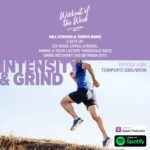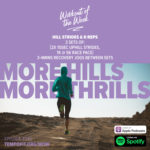
In the words of early 90s rapper Vanilla Ice, “Stop, collaborate and listen!” That’s what we’re doing with the strides thrown into break up this pretty meaty workout.
WHAT?
STRIDES & TEMPO #3
Two sets of:
[3x30s strides w/ 90s jogs
15mins @ lactate threshold (your 1-hour race pace)]
Recoveries: 3-minute jogs between sets
Terrain: A flat and measurable pathway.
The strides at the start set the tone for the rest of the workout by allowing you to work on good speed and technique while 100% fresh.
Then, in the middle of the session, we throw in another 3×30 seconds and these strides are designed as a system reset. Despite feeling tired and carrying fatigue in your legs, can you still switch into speedy mode and focus on the processes of great technique and pace.
WHY?
The strides and the tempo run each serve very different purposes. While the tempo run is there to tire you out and really test your body’s ability to go longer at a steady clip, the strides are all about the quality of the movement—not how hard you’re working.
HOW?
Nice long recoveries are key for performing strides well—hence the 90-seconds after each 30-second effort. And the recovery between the sets is also key as we want you as fresh as possible for that second lot of strides. So you may like to take longer than 3 minutes or turn it into three minutes of walking.
Also, if you are new to these longer sessions (the workout component, without warm up and warm down, is 45 minutes, so this is a big session) feel free to slow the tempo run down to half marathon or even marathon pace. Likewise, if you’re new to strides, you could do just 3×10 seconds instead of 30-second efforts.
THOUGHTS FOR THE WEEK:
WHAT DO YOU LISTEN TO WHEN YOU RUN?
By Hayden Shearman
Headphone technology has transformed the training experiences of runners. Podcasts, music, Spotify, audio books—they’re all MADE for running! However, are you getting the most out of what’s going through ear buds? Is it helping or hindering your training? And is it preparing you for race conditions?
Of course, everyone is different, but here are some tips on how I recommend to runners on how to use audio to maximise training and racing.
Racing: Most races do not allow any audio devices, so you need to do some specific training without the assistance of music or other audio to distract you from the discomfort you’re feeling. For example, if I’m preparing for a marathon I’ll make a deal with myself that any workouts I do at marathon pace, I will do it in silence so I can tune into what my body is doing at that pace. Be sure to check your upcoming race rules carefully.
Tempo Runs & Intervals: Apart from the above race paced example, most workouts I’m cranking up the music. For high intensity intervals I’m putting on high intensity tunes (for me it’s Rage Against the Machine or EDM). For steady state tempos I’m starting with something slower and rhythmical that will gradually build in intensity (my go-to is reggae or R&B).
Strides or Speed Work: When you’re trying to work efficiencies, speed and technique, I find I need full focus. Especially when you’re running full speed, because I’m trying to recruit EVERY muscle fibre, I need my full attention to get my body in that zone. Plus, I don’t want to be carrying a phone or have headphones to worry about (especially back in the days of cables. So, most strides or speed sessions I perform in silence.
Easy & Long Runs: If I’m running solo, the podcasts and audio books are ALWAYS on! I have an Audible subscription and I love that my running allows me to read a book every month without needing to set aside any extra time. In saying this, I do also like to switch off and enjoy nature and the meditative mental space that running helps create.
Hope that gives you some clues on how to use audio to assist your running. And if you want to check out some audio tools that we’ve created to assist you in your running, on the run, check out the Audio Coach series at tempofit.org/audio
Podcast (workout-of-the-week): Play in new window | Download
Subscribe: Apple Podcasts | RSS | More



